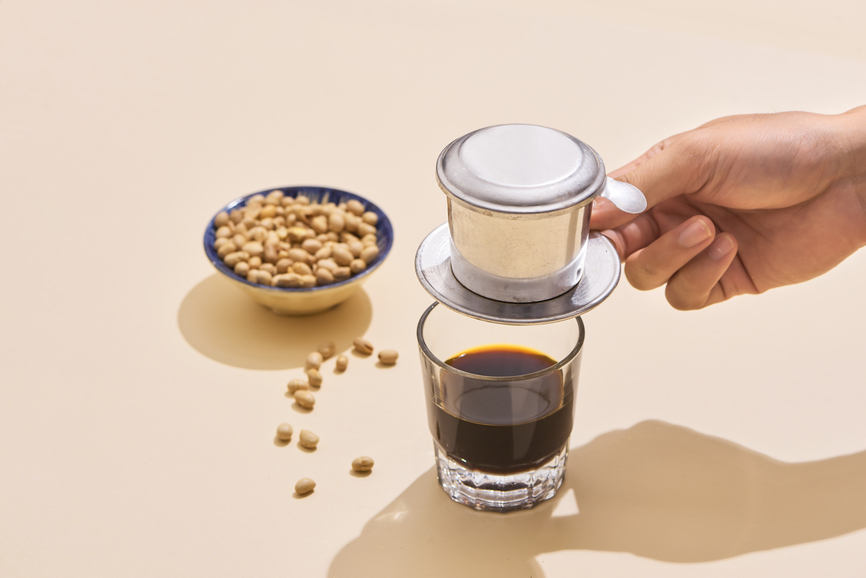Vietnam is the second-largest coffee producer in the world, and when you taste the delicious flavors expressed (“it’s me, hi, cafe sua da“) it’s easy to understand why.
To learn more about the rich history of Vietnamese coffee, we caught up with Debbie Wei Mullin, the founder of Copper Cow Coffee, a Vietnamese woman-owned coffee company. Ahead Mullin talks us through the nuances of making Vietnamese coffee, what inspired her to launch her own business, and her favorite way to prepare an authentic cup of Vietnamese brew. Plus, how she’s paying homage to her roots one cup of coffee at a time.
What is Vietnamese coffee?
According to Mullin, coffee was introduced in Vietnam several decades ago—dating back to the 1950s, as French colonizers brought the crop into the country. “The French first introduced coffee to Vietnam, which influenced Vietnam’s roast style—dark French roast—and how it’s consumed in the country,” Mullin says. “Like Paris, the streets of Vietnam are lined with coffee shops with chairs facing the street for patrons to sip on a strong coffee and watch the city go by.”
Although the two may share some similarities, unlike the French, Vietnamese coffee requires using one unique coffee-making tool: A phin. “Traditionally, Vietnamese coffee is made in a phin—a slow, small brewer that creates an incredibly strong shot of coffee over a five to 10-minute brewing cycle,” Mullin says. On its own, Vietnamese coffee is medium full-bodied with deep, rich flavors. “Vietnam is most famous for robusta coffee, which holds rich mocha and nutty undertones. It tastes particularly rich when roasted dark and pairs well with milk,” she says.
“Traditionally, Vietnamese coffee is made in a phin—a slow, small brewer that creates an incredibly strong shot of coffee over a five to 10-minute brewing cycle,” Mullin says.
Delving deeper into the flavor, Mullin notes that Vietnamese coffee has deep chocolate and nutty undertones because it’s typically dark-roasted. For contrast, she adds that coffees from South America and Africa tend to have more bright, herbal undertones. “South American and African varietals often lean on lighter or blonder roasts to highlight their floral and fruity notes,” she says.
So, the best way to drink it, you may wonder? Mullin says that traditionally, Vietnamese coffee is mixed with sweetened condensed milk and served over ice, otherwise known as cafe sua da. Swoon.
What inspired the launch of Copper Coffee Cow, a Vietnamese coffee company?
Mullin, an MIT graduate with a master’s in International Development and Sustainability, began her professional career managing loans for the world bank that supported projects aimed at increasing economic opportunity and reducing poverty in developing countries. But the industry wasn’t exactly what she had envisioned. “I didn’t find the world bank to be a good cultural fit for me, and I wanted to do something that supported supply chain development in Vietnam and that leveraged my love of Vietnamese cuisine. Once I learned that Vietnam was the second largest coffee producer in the world, it was like a light went off, and I haven’t looked back,” Mullin says.
In 2017, Mullin launched Copper Cow Coffee to realize two of her main passions in life: setting out to create better opportunities for folks in Vietnam and sharing her deep passion for Vietnamese cuisine and culture on a larger scale. “I didn’t get to grow up around many others with an Asian background, so all my exposure to Vietnamese food was only in my home and visits to extended family. While it was a huge part of my life growing up, I quickly saw that my surrounding community didn’t have access to some of my favorite staples. I always dreamed of figuring out a way to share these flavors that I value so greatly in the United States,” Mullin says.
Since then, Mullin has collaborated with many Vietnamese coffee producers to sustainably source high-quality beans free of any artificial ingredients. “Ultimately, I want this to unlock opportunities for cleaner farming and higher incomes for our coffee partners in Vietnam. I want to achieve this by making Vietnamese coffee a prominent category of the premium coffee market,” she says.
The company carries a wide range of products that fall into three main categories: ground coffee, pour-overs, and creamers. “Our ground coffee is the premium Vietnamese robusta and arabica blend, and we’re the only coffee company to flavor with real ingredients like whole ground cinnamon sticks ground into our churro coffee—our most popular product—or whole vanilla beans scraped into our vanilla coffee bags,” Mullin says. Then, they also offer their signature coffees in convenient pre-portioned, single-serve pour-overs that fit over any cup. Lastly, they carry sweetened condensed creamers made with no preservatives or artificial flavors that can be used to whip together a quick cup of cafe sua da at home.
How to make the perfect cup of Vietnamese-style coffee
Over the years, Mullin has crafted her go-to coffee recipe—and it’s a fusion of several influences in her life. “There really is no ‘wrong’ way to brew Vietnamese coffee. Maybe it’s because I’m so culturally mixed—I have Vietnamese, Chinese, Jewish, and Irish roots—that I’m so comfortable with mashing things up,” she says.
“That said, I do think that Vietnamese coffee is delicious when brewed strong, as an espresso, or with a traditional Vietnamese phin and paired with sweet milk—either a combination of oat milk and honey or with just sweetened condensed milk,” Mullin says.
See you at the coffee station in five?
An RD delves into the benefits of drinking coffee:
